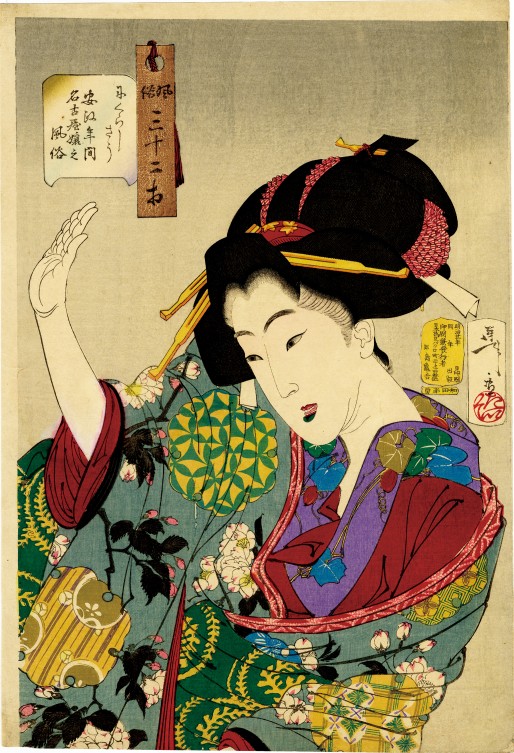歌麿
歌麿二代
英山
英泉
北尾 重政
国貞
国貞二代(国政二代)
国郷
国綱
国輝
国長
国麿
国丸
国安
春章
国芳
湖龍斎
貞虎
貞秀
式麿
春好
春潮
雪嶠
豊国
豊国二代
豊国三代
豊広
豊春
春信
広景
広重
広重二代
文調
北斎
柳川 重信
無款
芳員
芳艶
芳豊
芳虎
芳晴
芳福
芳房
芳藤
芳盛
栄之
永理
鶯斎
清長
清峯
国明
国直
国福
国政
貞房
春幸
春扇
春亭
豊久
直政
北寿
芳富
芳宗
了古
一景
暁斎
清親
吟光
国周
国輝二代
国直二代
月耕
耕漁
小国政
古邨
小信(貞信二代)
茂広
柴田 是真
春汀
昇雲
省亭
周延
年一
年方
豊宣
美邦
広重三代
房種
国政四代・香朝楼・豊斎
安治(探景)
芳幾
芳国二代
芳年
暁翠
無款
国輝三代
国利
耕耘
秀湖
春宣
雪斎
年信
年英
柳村
石川 寅治
石渡 江逸
伊東 深水
伊藤 孝之
エリザベス キース
小原 祥邨(豊邨)
笠松 紫浪
川瀬 巴水
小早川 清
小村 雪岱
高橋 松亭
土屋 光逸
鳥居 言人
名取 春仙
楢崎 栄昭
成田 守兼
バートレット
橋口 五葉
ピーター アーヴィン ブラウン
ポール ジャクレー
山村 耕花
吉田 遠志
吉田 博
井出 岳水
伊藤 総山
犬塚 苔翠
上原 古年
大野 麦風
河原崎 奨堂
北野 恒富
ノエル ヌエット
坂内 宏観
平野 白峰
ヘレン ハイド
山川 秀峰
山中 古洞
畦地 梅太郎
織田 一磨
小野 忠重
恩地 孝四郎
勝平 得之
川上 澄生
川西 英
小泉 癸巳男
関野 準一郎
戸張 弧雁
永瀬 義郎
平塚 運一
前川 千帆
山岸 主計
石井 鶴三
奥山 儀八郎
北岡 文雄
木村 荘八
山本 鼎
芳年 / 風俗三十二相 にくらしさう
SKU: C24142
スマートフォンのお客様は画像上でダブルタップすると拡大画像をご覧いただけます。
Please double-tap on the image to zoom up images.
作品
年代 : 明治21年
サイズ : 大判
刷 : 良
保存 : 良
詳細 : 小虫穴 / 少滲み
ディレクターコメント
「風俗三十二相」は明治21年から出版された芳年美人画の代表作で、明治美人の最高峰といわれている。女性たちが見せる多彩な表情をテーマとしており、「◯◯そう」の題名で描かれるのは、江戸時代の浮世絵にはあまり見られない、豊かな表情を見せる女性たち。三十二相とは仏が備える優れた身体的特徴を数えた仏教用語で、これを女性になぞらえた美人画は江戸時代から描かれているが、芳年の作品には、伝統的な美人画表現にとらわれない近代的な視点を感じ取ることができる。
芳年(天保10 - 明治25年)は、幕末から明治前期にかけて活動した浮世絵師。
多種多様な浮世絵を手がけ、各分野において独特の画風を見せる。明治期において最も成功した浮世絵師であり、「最後の浮世絵師」と評価されることもある。門下から日本画や洋画で活躍する画家を多く輩出したという側面もある。
また、芳年は芥川龍之介、谷崎潤一郎、三島由紀夫、江戸川乱歩など、文人たちにも愛された。精神を病みながらも創作をつづけた芳年の鬼気迫る情念がこもった究極の美は、世界中で人気が高い。
作品ページの見方とご購入ガイド
Information
Date : 1888
Size : O-ban
Impression : Good
Condition : Good
Detail : Small wormholes / Slight browning
"32 Conventional Aspects" is Yoshitoshi's masterpiece of that depicted ladies of the Meiji era and was published from 1888.
The theme of this series is the diverse expressions of women. The works under the title "~So" depict women with rich expressions that are rarely seen in Ukiyo-e of the Edo period. The "thirty-two phases" is a Buddhist term that counts the outstanding physical features of a Buddha, and although beauty paintings that compare women to these phases have been produced since the Edo period, Yoshitoshi's works show a modern perspective that is not bound by the typical expression of beauty painting.
The word "相 (so)" in the title describes the state of a person, and in Japanese, it is attached to an adjective to indicate what state a person is in. In English, the expression would be "looks like~." In this series, 32 different facial expressions were shown with the play on words "~so. (Looks like~.)."
Tsukioka Yoshitoshi (1839 - 92) was a Ukiyo-e artist who was active from the end of the Tokugawa shogunate to the Meiji era.
He created various artworks, and we can see his unique expression styles in each genre of the works.
He was one of the most essential and famous Ukiyo-e artists in the Meiji era and had many pupils who became famous in the Japanese and Western fields. Sometimes he is called "The last Ukiyo-e artist."
Many writers also loved him, such as Tanizaki Junichiro, Mishima Yukio, and Edogawa Ranpo. Moreover, the beautiful and fascinating artworks that were kept creating even though he was in a mental disorder enthralled people worldwide.
Shopping Guide & Information of the Japanese Prints
Please double-tap on the image to zoom up images.
作品
年代 : 明治21年
サイズ : 大判
刷 : 良
保存 : 良
詳細 : 小虫穴 / 少滲み
ディレクターコメント
「風俗三十二相」は明治21年から出版された芳年美人画の代表作で、明治美人の最高峰といわれている。女性たちが見せる多彩な表情をテーマとしており、「◯◯そう」の題名で描かれるのは、江戸時代の浮世絵にはあまり見られない、豊かな表情を見せる女性たち。三十二相とは仏が備える優れた身体的特徴を数えた仏教用語で、これを女性になぞらえた美人画は江戸時代から描かれているが、芳年の作品には、伝統的な美人画表現にとらわれない近代的な視点を感じ取ることができる。
芳年(天保10 - 明治25年)は、幕末から明治前期にかけて活動した浮世絵師。
多種多様な浮世絵を手がけ、各分野において独特の画風を見せる。明治期において最も成功した浮世絵師であり、「最後の浮世絵師」と評価されることもある。門下から日本画や洋画で活躍する画家を多く輩出したという側面もある。
また、芳年は芥川龍之介、谷崎潤一郎、三島由紀夫、江戸川乱歩など、文人たちにも愛された。精神を病みながらも創作をつづけた芳年の鬼気迫る情念がこもった究極の美は、世界中で人気が高い。
作品ページの見方とご購入ガイド
Information
Date : 1888
Size : O-ban
Impression : Good
Condition : Good
Detail : Small wormholes / Slight browning
"32 Conventional Aspects" is Yoshitoshi's masterpiece of that depicted ladies of the Meiji era and was published from 1888.
The theme of this series is the diverse expressions of women. The works under the title "~So" depict women with rich expressions that are rarely seen in Ukiyo-e of the Edo period. The "thirty-two phases" is a Buddhist term that counts the outstanding physical features of a Buddha, and although beauty paintings that compare women to these phases have been produced since the Edo period, Yoshitoshi's works show a modern perspective that is not bound by the typical expression of beauty painting.
The word "相 (so)" in the title describes the state of a person, and in Japanese, it is attached to an adjective to indicate what state a person is in. In English, the expression would be "looks like~." In this series, 32 different facial expressions were shown with the play on words "~so. (Looks like~.)."
Tsukioka Yoshitoshi (1839 - 92) was a Ukiyo-e artist who was active from the end of the Tokugawa shogunate to the Meiji era.
He created various artworks, and we can see his unique expression styles in each genre of the works.
He was one of the most essential and famous Ukiyo-e artists in the Meiji era and had many pupils who became famous in the Japanese and Western fields. Sometimes he is called "The last Ukiyo-e artist."
Many writers also loved him, such as Tanizaki Junichiro, Mishima Yukio, and Edogawa Ranpo. Moreover, the beautiful and fascinating artworks that were kept creating even though he was in a mental disorder enthralled people worldwide.
Shopping Guide & Information of the Japanese Prints
最近見た作品






